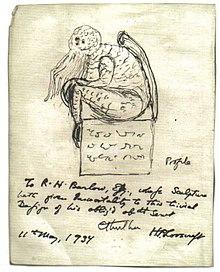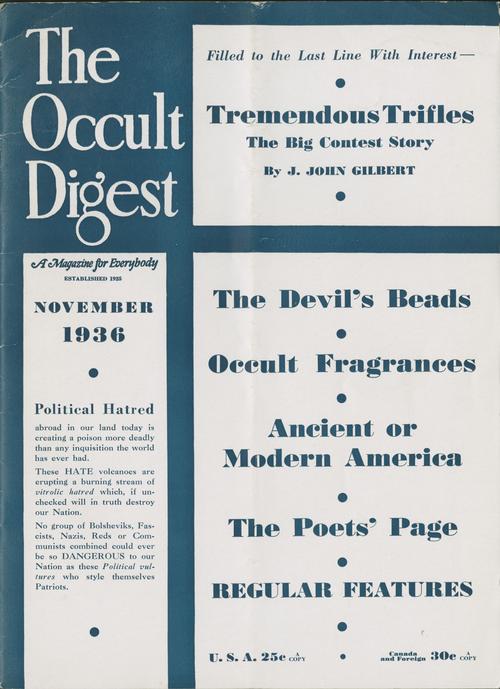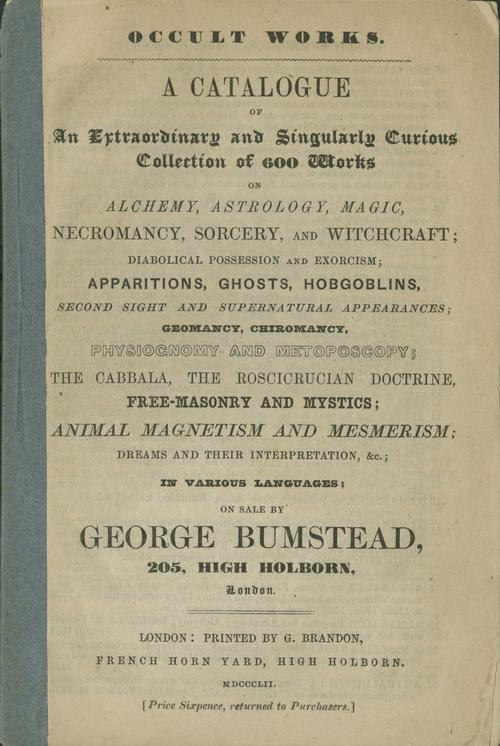Dana Porter Library, first floor
University of Waterloo Library
Waterloo, Ontario N2L 3G1
519-888-4567 x42619 or x42445
With Halloween coming up soon, I found it fitting for my first blog post as the new Special Collections & Archives Co-op student to follow a theme of the supernatural. When I first started working here in the Rare Book Room, I quickly realized that there would be all sorts of random topics covered in the vast collection we have down here on the first floor of the Dana Porter Library. Luckily, there are plenty of books and magazines that fit perfectly within the themes of Halloween.
Starting off, we have the various novellas and short stories by the posthumously-famous horror-fiction writer H.P. Lovecraft. Most people today will probably know of Lovecraft due to one of the most famous characters from his stories, Cthulhu. If you’re a fan of Rick and Morty, you’ll recognize Cthulhu as the massive squid monster featured at the end of all of the show’s opening credits. This monster is the perfect representation of Lovecraftian horror, otherwise known as cosmic horror. The central idea behind this subgenre is that when compared to the vastness of the observable universe, man is ultimately insignificant.
If your tastes in horror are a bit more modern, you can check out “Fear Itself”, a group of critical analyses of Stephen King’s early work (call number G04385). While it doesn’t contain any actual horror stories, it does give you an interesting look into King’s work, especially considering the fact this book came out pretty early on in King’s career. What makes our copy rare enough to be included in the Rare Book Room is that it has been signed by King himself. So if you’re a long time fan of Stephen King or, like me, have only just become one due to the antics of a dancing sewer clown, it’s certainly a book worth looking through.
Front cover of "Fear Itself" with scenes from King's early work
For those of you who enjoy delving into the dark and strange mysteries of the occult, with a 1930s twist, look no further than the “Occult Digest” magazine (call number BF 1001 .025). From palmistry to astrology, ghost stories to poems, “Occult Digest” has a surprisingly large variety to capture practically any reader’s interest, regardless of whether or not you believe any of it. My personal favourite articles are the ones that predict the future. As all of our copies of the “Occult Digest” were written in the 1930s, and 20th century history being one of my favourite subjects, it was fascinating to me to get some level of foresight rather than hindsight into this time period, directly from someone actually living in it. In the January 1937 issue, Occult Digest’s resident astrologer, Haasan Osiris, makes many predictions for some of the most powerful countries at the time, with varying degrees of accuracy. However right or wrong he was--and when he used such vague terms, it’s hard to say he was completely wrong--Mr. Osiris’ predictions give us an unusual look into the world’s political atmosphere just two years prior to the start of the Second World War.
For a magazine from the 1930s, the political statement made on the left hand side of the cover is surprisingly fitting for today's volatile climate.
In case you’re bored and want to look further into the occult, one of our most recent acquisitions is a catalogue of around six hundred books that cover all sorts of things relating to the paranormal and supernatural (call number F25085). Alchemy, necromancy, witchcraft, ghosts, geomancy, and even animal magnetism are just some of the many topics included. Hopefully this pamphlet will help us here at the Special Collections & Archives to locate new books to add to our Spiritualism and Theosophy collection and it may even inspire you to find some of these books yourself.
Occult Works. A Catalogue of An Extraordinary and Singularly Curious Collection of 600 Works on Alchemy, Astrology, Magic, Necromancy, Sorcery, and Witchcraft; Diabolical Possession and Exorcism; Apparitions, Ghosts. Hobgoblins, Second Sight and Supernatural Appearances; Geomancy, Chiromancy, Physiognomy and Metoposcopy; The Cabbala, The Roscicrucian Doctrine, Free-Masonry and Mystics; Animal Magnetism and Mesmerism; Dreams and Their Interpretation, &c.; in Various Languages: on Sale by George Bumstead, 205, High Holborn, London.
Yes, that is the full title








